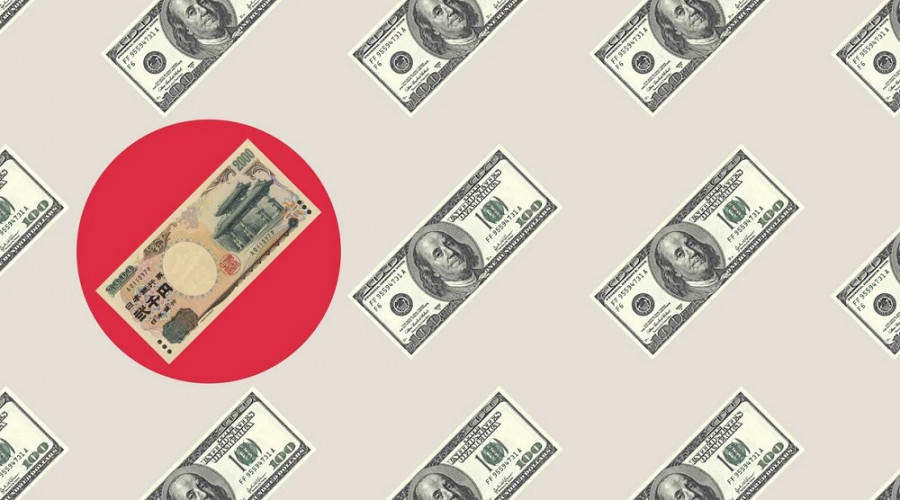The US dollar showed mixed dynamics on Wednesday. The US Dollar Index initially reached a two-week high of 104.27 but then reversed and moved the other way. Major dollar pairs are adjusting accordingly, following the greenback's lead. However, the USD/JPY pair is moving downward regardless of whether the dollar appreciates or depreciates. This "anomaly" is attributed to several reasons.

Let's start with the fact that Japanese authorities conducted two consecutive currency interventions two weeks ago when the USD/JPY pair approached the 162 level. According to Japanese news agency Kyodo, a currency intervention of $22 billion was carried out on July 11, followed by another intervention worth $13 billion on July 12. Representatives of the government and monetary authorities have remained silent: the Ministry of Finance and the Bank of Japan have yet to announce the intervention, and all related questions are left unanswered (typically, Japan's authorities announce interventions several months later).
This means that the USD/JPY pair started to decline based on quite strong fundamental reasons.
Furthermore, the greenback reinforced the downward trend, which came under significant pressure due to the slowdown in the US CPI and dovish rhetoric from Federal Reserve Chair Jerome Powell. The probability of a rate cut at the September meeting has risen to 95%, and the chances of an additional cut in November or December are assessed by the market as 50/50.
Donald Trump helped the US dollar recover last week by strengthening his position in the election race. However, firstly, this "help" was short-lived (Trump's chances of winning slightly decreased after Biden exited the race), and secondly, USD/JPY traders effectively ignored the greenback's growth. Buyers could only manage a modest correction, allowing bears to enter sell positions at a more favorable price.
This week, the USD/JPY pair continues to follow its own path. Whether the greenback appreciates or depreciates, the price stubbornly maintains its downward course. What drives such persistence from sellers? Will the effect of the (unconfirmed) currency intervention last for the third consecutive week?
In my opinion, the primary driving force behind the downward movement is the hawkish rumors regarding potential actions by the Bank of Japan at its July meeting. The meeting is scheduled to take place exactly one week from now, on July 30 and 31.
Market confidence is growing that the Japanese central bank will increase the interest rate by 10 basis points, taking another step towards normalizing monetary policy. The reason is persistent inflation, which still exceeds the bank's target level.
According to data published last week, the overall Consumer Price Index rose by 2.8% year-on-year in June, remaining at the same level as the previous month. The core index, excluding fresh food, increased by 2.6% (the highest value in the past three months) after rising by 2.5% in May. Inflation, excluding food and energy, was 2.2% (compared to 2.1% in May).
The key inflation indicator tracked by the Bank of Japan has been above the two-percent target for over two years and has even accelerated over the last two months (May and June).
Bank of Japan officials have recently expressed their concern about rising inflation, suggesting the possibility of tightening monetary policy. In particular, the head of the Central Bank, Kazuo Ueda, mentioned in one of his speeches that the regulator might raise the interest rate at one of the upcoming meetings. Notably, these remarks were made before the publication of June CPI data, which reflected an acceleration in core inflation.
The combination of these fundamental factors is driving the USD/JPY pair downward. This downward trend could intensify significantly if the U.S. economic growth data for the second quarter and the PCE core index growth report fall into the "red ." These crucial reports are scheduled for release on Thursday and Friday, and their outcomes could have a substantial impact on the USD/JPY pair.
From a technical standpoint, the USD/JPY pair is currently positioned at the lower line of the Bollinger Bands indicator on the H4 and D1 timeframes, below all lines of the Ichimoku indicator, which has formed a bearish "Parade of Lines" signal. On the weekly chart, the Ichimoku indicator will also form this signal once the pair crosses the 154.00 target (Kijun-sen line). In other words, the "technical" aspect also suggests a priority for short positions, with targets at 153.50 and 153.00. Given the strength of the downward movement, it is highly likely that these levels will be tested this week, unless the aforementioned U.S. macroeconomic reports intervene and support the struggling dollar.
The material has been provided by InstaForex Company - www.instaforex.com #














 Download NOW!
Download NOW!
No comments:
Post a Comment